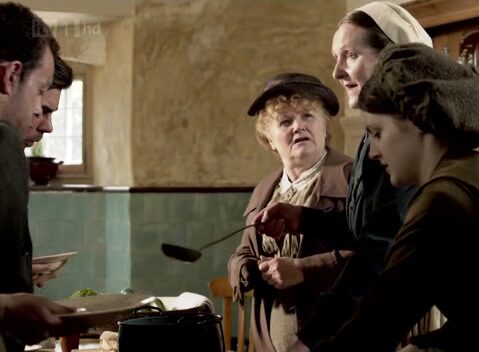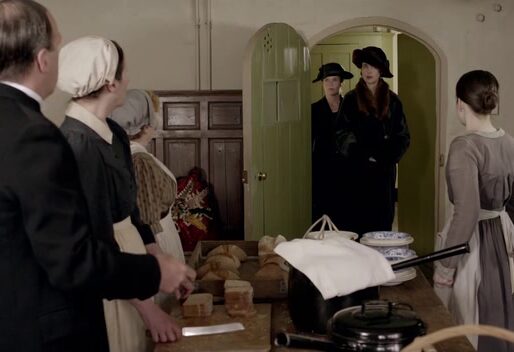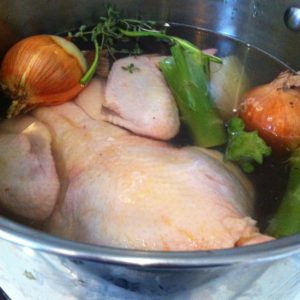
There is much happening in the WWI world of Downton Abbey. In the most recent episode aired on PBS (Season 2, Episode 4), Ethel gets her wish for a life outside of service, Matthew and William play hide and seek with the Hun, miracles occur when the Crawley sisters perform a duet for the officers, and Isobel and Cora vie for world domination (of Downton Abbey, at least.) For the romantics in the audience, Branson is not fired for plot to serve a special soup to the visting General, giving him more encouragement to pursue his love for Sybil. Lord Grantham has a very busy schedule: he has to track down and fetch Mr. Bates, and deal with the news that Sir Richard has proposed to Mary.

With all that drama, the writers still have time to show us life outside the privileged world of Downton. I don’t know how they do it! After Cora calls her bluff, Isobel has left in a huff to go where she can do service, which apparently is in France, leaving Mrs. Bird and Molesley with little to do at the Crawley house. A war veteran some how breaches security and asks for spare food. Once you feed one, they tell their friends, and so launched Mrs Bird’s soup kitchen. Mrs. Patmore and Daisy, wandering by the Crawley house, discover the enterprise and begin to bring food from the Downton estate to help the cause. O’Brien, quick to sniff a scandal, drags Cora over to the Crawley house to catch the thieves in the act. To her dismay, Lady Cora not only applauds their initiative, but forces O’Brien to help.
History of the Soup Kitchen
Food relief has been a main stay of humanitarian missions in third world nations, but unfortunately bread lines are no longer just a distant memory of The Great Depression in the Western World. The current economic climate has again made food banks and soup kitchens a necessity. It is a blessing that in the midst of hunger, there are always those who come along to serve and give comfort. The Bible teaches Jesus’ compassion for the less fortunate, and in the accounts of Mark, Luke, and John the story is told of one of Jesus’ greatest miracles: feeding 5000 men with only 5 loves of bread and 2 fishes (Mark 6:30-44). Some may argue that turning water into wine (John 2:1-11) was an even greater miracle (John 2:1-11), but I digress.

While he was hardly the first person to come up with the idea to feed the poor, American born Count Rumford has been credited with establishing the first soup kitchens. Born Benjamin Thompson, Count Rumford is famed as a scientist, a diplomat, military administrator, inventor, culinary expert, philanthropist and social philosopher. He also earned well-deserved reputation for being an arrogant and abrasive, but then again so did Steve Jobs.
He fled to Britain during the American Revolution, labelled as a British Loyalist. There are a few different accounts as to how the soup kitchen evolved after that (in the late 1700s). He had earned the title of Count from the Bavarian Government. In a plan to rid Munich of beggars, The Smithsonian blog explains that he had the army round up beggers and their children, putting them into workhouses to make military uniforms. The workers needed to be fed and Rumford created a nutrient rich soup make of peas, barley, and broken white bread (the invention of the crouton), to serve. Soon soup houses were established throughout Europe, England and the United States to feed the poor. In London, as many as sixty thousand people were fed daily from Rumford’s soup kitchens.
Rumford’s innovations in the kitchen also included the cast-iron Rumford stove (the first commercially available kitchen range), which kept in heat and allowed temperature to be regulated better than on an open hearth; a pressure cooker (though not necessarily the first one); and a drip coffee maker.
Check out enotes if you would like to learn more about the evolution of soup kitchens
Glorious Soup
Hot and hearty homemade soup not only provides nourishment for a large number of people, it soothes and warms the soul during winter months. Soup really easy to prepare, great for stretching your food budget. I often have a large batch of soup simmering on the stove for its additional aromatherapeutic effects. I freeze most of the soup, which my husband and I are able to enjoy for our daily lunch together. The shape of the container makes it easy to pop out in a 3 quart pot. I add some additional broth and bring to a simmer to thaw and reheat.
Check out for the full collection of my soup recipes.
Mrs. Beeton’s Barley Soup
From Mrs. Beeton’s Book of Household Management, 1861
INGREDIENTS – 2 lbs. of shin of beef, 1/4 lb. of pearl barley, a large bunch of parsley, 4 onions, 6 potatoes, salt and pepper, 4 quarts of water.
Mode.—Put in all the ingredients, and simmer gently for 3 hours.
Time.—3 hours. Average cost, 2–1/2d. per quart.
Seasonable all the year, but more suitable for winter.
Upstairs: Cream of Barley
A traditional barley soup which was served to 1st class passengers on the Titanic. Soup in the Downton era upstairs dinner are not very substantial, since there were many, many courses to follow. No cream in this version so no threat to your diet.
Titanic's Cream of Barley Soup
Ingredients
- 1/3 cup pearl barley
- 2 tbsp. unsalted butter
- 1 small onion finely chopped
- 1 small carrot finely chopped
- 1 stalk of celery, finely chopped
- 8 cups chicken stock
- 1 large egg yolk (I freeze the white for another purpose)
- 1 pinch salt and freshly ground pepper
- 1 whole nutmeg freshly grated
- 2 sprigs fresh parsley chopped for garnish
- fried bread croutons (optional)
- nonfat strained yoghurt to drizzle (optional)
Instructions
- Wash the barley, heat in a pot of cold water to the boil for a few minutes, then drain and let cool.
- Melt the butter in a medium saucepan, and sauté the vegetables until lightly browned.
- Add the barley and chicken stock and simmer uncovered for an hour or two. The longer the better in my view to give the flavours a chance to full blend.
- Strain into a clean saucepan and season with a touch of nutmeg, salt and pepper. Save the vegetables to add to your servants hall soup, or you can enjoy a nice little snack of flavourful barley.
- To incorporate the egg without it curdling, temper it by spooning a little of the liquid into a separate small bowl, add the egg yolk and mix well. Stir this back into the soup pot.
- Reheat the mixture, but don’t let it boil or the egg with curdle.
- Sprinkle with chopped parsley and bread croutons, and drizzle a little yoghurt if you like before serving.
Downstairs: My Favourite Beef and Barley Soup
Comforting Beef and Barley Soup
Ingredients
- 1/4 cup (1/2 stick) butter
- 2 cups chopped onions
- 1 cup chopped peeled turnip
- 1 cup cauliflower florets
- 1 cup broccoli florets
- 1 cup chopped peeled yams (red-skinned sweet potatoes)
- 1 cup chopped peeled potatoes
- 1 cup chopped celery
- 5 cups beef stock or canned beef broth
- 5 cups homemade chicken stock or low-salt chicken broth
- 1 cup pearl barley
- 1 1/2 tbsp. chopped fresh thyme
- 1 1/2 tbsp. chopped fresh oregano
- 1 1/2 pounds stewing beef cut into 1/2-inch pieces
- 1/4 cup chopped fresh parsley
Instructions
- Melt butter in heavy large pot over medium heat.
- Add vegetables; sauté 10 minutes. (you can add your beef bone at this stage, if you like)
- Add both stocks; bring to boil. Reduce heat and simmer 20 minutes, skimming fat if you have added the bone. At this point I will simmer for a few hours.
- Add barley, thyme and oregano.
- Simmer until barley is tender, stirring occasionally, about 35 minutes. This can be made 1 day ahead.
- Add beef to soup; simmer until just cooked, about 10 minutes.
- Mix in parsley. Season with salt and pepper.
Notes
Make your Own Stock
Beef Bone Broth
Ingredients
- 4-5 lb meaty beef and veal bones
- 1 lb. stew meat
- 2 large onions peeled and quartered
- 2 large carrots roughly chopped
- 1 splash olive oil
- 1 bunch Celery stalks and leaves
- 1 bunch broccoli stems
- 2 cloves garlic unpeeled
- 1 handful parsley stems and leaves
- 1 large bay leaves
- 10 loose peppercorns
Instructions
- Preheat oven to 400°F/200°C/Gas 6.
- Place stock bones, stew meat or beef scraps, carrots and onions in a large, shallow roasting pan, and drizzle some olive oil on top.
- Bake for 45 minutes, turning the bones and meat pieces halfway through the cooking, until browned. Transfer the meat and vegetables to a large stock pot.
- Deglaze the roasting pan on low heat by pouring a little water in the pan and scraping up all of the browned bits stuck to the bottom of the pan. Pour the browned bits and water into the stock pot.
- Add the remaining ingredients into the pot, and fill with water so it is about 1 inch (2.5 cm) above the bones.
- Turn the heat to high and bring to a boil, then reduce the heat to low. Partially cover the pot and let simmer untouched for 3–4 hours, occasionally skimming the scum that rises to the top.
- I let the stock simmer for the afternoon, but it should be left for at least 3 hours. Remove from the heat and take out the vegetables, meat and bones. You can reclaim the stew meat for a soup, and if you are a fan of marrow, now is the time to dig in. Let the mixture cool, then strain the stock into tall containers which take up less room in your refrigerator. Refrigerate and you will see that the fat has risen to the top and created a white layer. You can easily pick it off and discard.
- Once cooled, the fat will rise to the top which you can now easily remove.
- You can now use the stock which will keep in your refrigerator for a few days. Freeze the rest in plastic containers for future use. I also freeze some in ice cube trays, transferring into a plastic bag. One or two cubes are great for the times when you only need a little stock to add to a dish.
Abbey Chicken Broth
Ingredients
- 3 pound chicken or a mix of bone in chicken breasts and thighs
- 1 pound unpeeled onions trimmed and cut into eighths
- 2 ribs celery halved lengthwise and coarsely chopped
- 4 stems broccoli
- 1 large carrot coarsely chopped
- 3 large garlic cloves peeled and coarsely chopped
Instructions
- Place all the ingredients into a large stock pot.
- Add 4-6 cups of water to cover all the ingredients and bring to a boil.
- Lower the heat, cover partially and skim occasionally until the chicken is cooked. This will take an hour.
- Take the chicken out and when cooled, take the meat off the bones and cut or shred into pieces. Save for a meal or wonderful chicken noodle soup.
- Use a strainer to separate the liquids from solids. I like to press down on the solids to let some of the flavour come through, but it will give you a slightly more cloudy stock.
- If you are going to use right away, use a fat separator if you have one to remove the fat, or you can blot the top of the surface with paper towels, add ice cubes or simply skim with a large flat spoon.
- Cool immediately in large cooler of ice or a sink full of ice water to below 40 degrees. Place in refrigerator overnight. Remove solidified fat from surface of liquid and store in container with lid in refrigerator for 2 to 3 days or in freezer for up to 3 months.
- Wonderful in chicken noodle soup (see link below). I always keep a supply of soup frozen on hand when someone in the family is starting to feel unwell.
Notes
Must Have Items for Downton Abbey Fans






